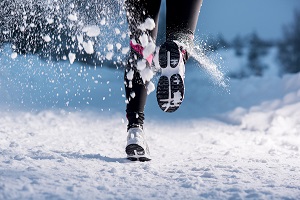
- Choose a synthetic sock. Avoid cotton socks. Synthetic sock (wool blend, polypropylene) wick away moisture and help prevent blister formation and cold feet.
- Run in a trail shoe. Winter running involves slick surfaces on both the trails and the street. It is important to have more support and stability on slippery surfaces. Trail shoes have more traction for these surfaces. Trail running shoes also tend to protect your feet more than lighter nylon running shoes.
- Dress in layers. Your first layer should be something like polypropylene that will wick sweat away from your body. For the outer layer, try a material such as nylon or Gore-Tex. This will protect your body against precipitation and wind and also let out heat and moisture from your body to prevent overheating or chilling. Avoid cotton because it holds moisture and likewise will keep you wet during your run. On really cold days you can even add a middle layer of clothing such as polar fleece.
- You should dress as if it is 5-10 degrees warmer than it actually is. When you first step outside, it should feel a bit cool. This will allow your body to heat up during your workout without over-doing it and perhaps dehydrating when running in the cold.
- Avoid uneven terrain. In cold weather it is more difficult to adjust to uneven terrain because your muscles do not react as quickly. Choose level streets and sidewalks and choose trails with fewer rocks, roots and dips. This will help minimize your chances of developing muscle strains and sprains.
- Warm up slowly. Although this may seem obvious, it is a common mistake in the winter. It is cold out and you will want to start running as soon as you close your front door. But, your muscles take longer to warm-up in colder weather. Your chances of injury increase when you do not take the time to warm-up properly.
Sometimes the most challenging part of winter running is stepping out the door. But once you’re out, happy trails.
For more articles go to http://lifesportfitness.lifestyleezine.com
